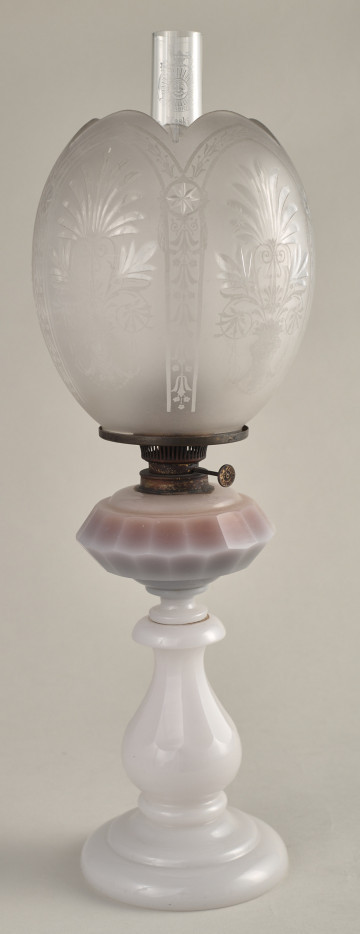
Wall lamp
20th century
Castle Museum in Łańcut
Part of the collection: Lampy, żyrandole i kinkiety
The concave upwards-open lamp originated in ancient Rome, gaining most popularity in the 19th century. Such lamps were usually made of alabaster, porcelain or glass. Alabaster is a kind of fine-grained gypsum, easily workable, and characterised by high translucency and various colours. Alabaster was used in sculpture since ancient times, it was also used to make lamps. The Potoccy collection lamp is in classic revival style, electrified, from the 19th century. It is shaped as a deep, conical bowl, around the upper edge decorated with a broad band of meander, decorated at three spots (edge) with an overlaid ornament shaped like horned goat heads in oval wreaths of leaves and fruit. The goat heads carry three chains with small, round links, which are radially joined above, at a rosette, to which a strong chain is attached, on which the lamp is suspended. The underside of the lamp is decorated by radially arranged, sculpted leaves, decorated on four sides, with an overlaid ornament of palmette with two cupids sitting on both its sides. The palmette ends with a gargoyle head. The lamp is finished with a floral rosette. It is made of alabaster, ornaments of gilded and finely finished bronze, inside the body there are light bulbs. Light bulbs emit light by a tungsten filament heated by the flow of electric current. Despite the broad use of light bulbs today, they are not as efficient a source of light as they may seem, because only around 5% of the energy create by the current flow through the filament, is turned into light, and 95% is emitted as heat. This lamp adorns the Column Hall on the first floor of the castle.
Object type
Lamps, chandeliers and sconces
Technique
sculpture
Material
bronze, alabaster
Origin / acquisition method
decyzja administracyjna
Creation time / dating
Owner
Castle Museum in Łańcut
Identification number
Location / status

20th century
Castle Museum in Łańcut

20th century
Castle Museum in Łańcut

19th / 20th century
Castle Museum in Łańcut
DISCOVER this TOPIC
National Museum in Lublin
DISCOVER this PATH
Educational path